The most simple definition of motivation is wanting something. Motivation is driving force for an individual. The word motivation is derived from the word ‘motive’, which means a person’s need, desire, wanting to do something, or an urge. Motivation keeps a person going ahead in life. It is the process of motivating individuals to take actions in order to achieve a goal. Motivation keeps people’s desires fuelling, it energizes them to achieve things.
In Human Resource Management employee motivation is very important because it enhances the level of commitment, energy and innovation. The job of HR is strategic in nature because it addresses the issues related to people. Human mind is most complex and working with minds continually is a tedious and time-consuming process. HR needs to measure employee wellbeing by measuring their motivation.
Here below are some of the famous motivation theories:

Abraham Maslow’s need hierarchy
Abraham Harold Maslow was an American psychologist. He developed a model of hierarchy of needs to explain human motivation. His theory proposed that people have a number of basic needs that must be met before people move up the hierarchy to pursue more social, emotional, and self-actualizing needs. The pyramid of needs is explained as below:
Physiological Needs
The theory generally is portrayed as a fairly rigid hierarchy in shape of pyramid. The physiological needs are at base which include food, water, clothing, sleep, shelter and reproduction. These are the basic necessities for any individual’s survival.
Safety Needs
After physiological needs come Safety Needs. These include protection from bad elements in society, security, law and order, stability, strength and freedom from fear. Once a person’s basic needs are satisfied, he requires safety and security as want for order and predictability sets in.
Social Needs
These include friendship, family, friend’s circle, memberships of various groups and clubs, work group, educational qualifications, salary, community belonging etc, in short, each person seeks affiliation in society.
Esteem needs
This category includes achievement, mastery, independence, status, dominance, prestige, self-respect, and respect from others.
Self-Actualization needs
This is at the peak of need pyramid. This includes realizing personal potential, self-fulfilment, seeking personal growth and peak experiences.
Maslow felt that there was a clear distinction between gaining love and gaining respect or esteem. He felt that people get respected for their exceptionality and mastery. As individuals, we naturally wish to excel or be exceptional, to be noticed for our unique talents and capabilities. Each one has some measure of self-esteem and confidence; at some point in time, we try to raise the bar of our performance, and once we achieve mastery, we automatically gain the psychological freedom to be creative and grow further. The growth gives us wisdom and the wisdom make us generous to others for sharing our mastery.
Maslow noted that the order in which these needs are fulfilled need not always follow this standard of succession. For example, for some individuals, the need for self-esteem is more important than the need for safety. Another fact is age, race, cast, creed, gender, height, weight, money, status has got nothing to do with the order of achieving each need.
Many other motivation theories are born out of Maslow’s Need Pyramid Theory.
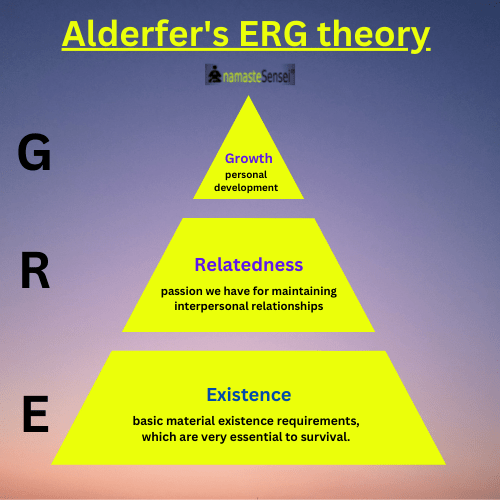
Alderfer’s ERG theory
Clayton Paul Alderfer was an American psychologist and HR consultant known for additionally developing Maslow’s hierarchy of needs. Alderfer’s ERG theory of 1969 condenses Maslow’s five human needs into three categories: Existence, Relatedness and Growth. All three include material and physiological desires.
Existence needs
These include need for basic material necessities. In short, it includes an individual’s physiological and physical safety needs. Housing, clothing, food, health are the needs for basic existence. Maslow’s physiological and safety needs fall under this category.
Relatedness needs
These include the individual’ ambition to maintain significant interpersonal relationships. We all feel the need of belonging to individuals and groups in our personal and professional lives. We all try to maintain relationships with significant others like family, friends, co-workers and employers. We like to cherish social esteem. This means to be recognized and feel secure as part of a club, social organization, group and our extended family. Getting public fame and recognition nourishes our self-worth. Maslow’s social needs and esteem needs fall under this class of need.
Growth needs
These include need for self-development. Growth need refers to the necessity for personal growth and self-discovery which a person continues throughout his life. For Maslow, a person is always ‘becoming’ ‘developing.’ A person never remains static. At every stage of life person grows mentally and physically. The realization or fulfilment of one’s talents and potentials and fulfilment of those is called self-actualization.
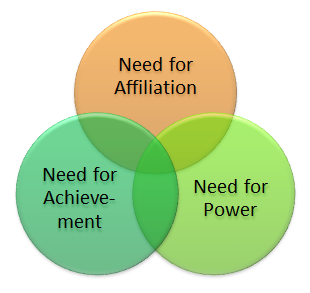
McClelland’s achievement motivation theory
David McClelland’s Human Motivation Theory helps to identify motivating drivers of people. This helps to praise them and give feedback effectively. McClelland states that every person has one of the three main driving motivators: the needs for achievement, the need for affiliation and the need for power. These motivators are not inherent, we develop them through our culture and life experiences. Each person is motivated by either one of these motivators – power, affiliation and achievement. In each person, one of these drivers is usually more dominant, but the others are present.
Power
If an individual’s predominant motive is power, they are motivated to influence others and take control. Power must not be perceived negatively, when it is pursued for the right reason, it is found tremendously powerful. McClelland found that power-motivated individuals were best suited for leadership positions within a company. If they were able to effectively delegate tasks in the workforce, they were often able to be successful leaders.
While history has seen some power-hungry rulers such as Joseph Stalin, Adolf Hitler, Pol Pot and Idi Amin who used their power for cruelty we also have examples of some good leaders such as Subhash Chandra Bose, Nelson Mandela, M.K.Gandhi and presently Narendra Modi.
Leaders enjoy power when they possess ability to influence others. Power is required for attaining organizational and institutional goals. Power is a doble-edged sword if not used properly, it destroys organizations.
Achievement
If an individual’s predominant motive is achievement, he will be satisfied only after achieving. Achievement-oriented individuals change the situation or the location when they want to. When achievement becomes need of a person, he/she chases the achievement. Such individuals do not like working in groups because they do not like having limited control over the outcome. Instead, they prefer to do work where the results are clear and visible. Successful entrepreneurs are achievement-oriented. They value accomplishment and the intrinsic rewards that go along with achieving difficult goals. It is a strong motivator for most business owners. Some excellent examples of achievement-oriented people are M.S.Dhoni, Sachin Tendulkar, Amitabh Bachchan, Dhirubhai Ambani, G.D.Birla, Azim Premji etc.
Affiliation
If an individual’s predominant desire is affiliation, they are essentially motivated by social connections. The need for affiliation itself as an emotional drive towards being liked and accepted. Individuals with a high need for affiliation desire having agreeable and collaborative working relationships with others and a pleasant social environment.
People who have a strong drive for affiliation, are ready to fit in a group by hook or by crook. Belonging to others is a primary human need. They are flexible they try to please others. They value their relationships in life the most. These individuals appreciate familiar situations and familiarity everywhere in life. They are unlikely to leave their work location. They also do not like working alone and try to avoid disappointing their co-workers and managers at all costs. Even though affiliation-motivated individuals work well in a team, they are often not the best employees. They are not motivated to do better as they are contented to stay in their position. There is no drive to improve their employee status or their personal position, which makes them not so effective workers.
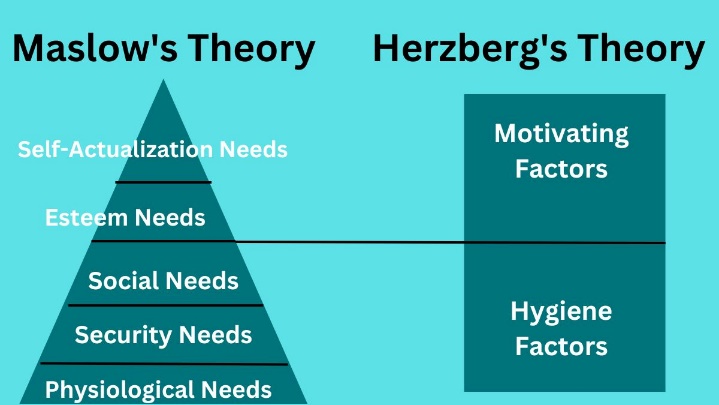
Herzberg’s motivation-hygiene theory
Fedrick Herzberg’s behavioural theory is considered as one of the oldest theories that describes job factors which inspire employees. Herzberg was a contemporary of Abraham Maslow who had coined the need pyramid theory. Psychologist Fredrick Herzberg tried to find answer to a most pertinent question in 1950s and 1960s, what people want from their employment, what makes employees satisfied in an organization? He conducted a study by asking people to describe situations in which they felt really good, and really bad, about their jobs. What he found was that people who felt good about their jobs gave very different responses from the people who felt bad. Person to person they varied.
Hygiene factors
These are the job factors which are essential for existence of motivation at workplace. The hygiene factors symbolize the physiological needs which the individuals want and are expected to be fulfilled in their work place. However, these do not lead to positive satisfaction for long-term. Therefore, they are also called dissatisfiers. But, if these factors are not present, they lead to discontent. In other words, hygiene factors are those factors which pacify the employees. Salaries, fringe benefits, canteen facilities, position, work culture and job security are hygiene factors in a job.
Motivators
The other feature is called motivators or satisfiers. These are linked to employee motivation which arises from built-in or dependent conditions on the job itself. The motivational factors are referred to as self-worth or self-respect. This is an important part of employment for many. Self-esteem is more important for numerous people. A person’s overall sense of self-worth or his personal values adds productivity to his style of working. The motivational factors for gratification include recognition, responsibility, job satisfaction, contests, achievement, opportunities for growth, anything that helps in advancement of career. The realization and fulfilment of one’s talents and potentials help these employees in achieving actualization. Herzberg’s motivators can be described as Maslow’s self-esteem and self-actualization which is an innate drive for some employees.
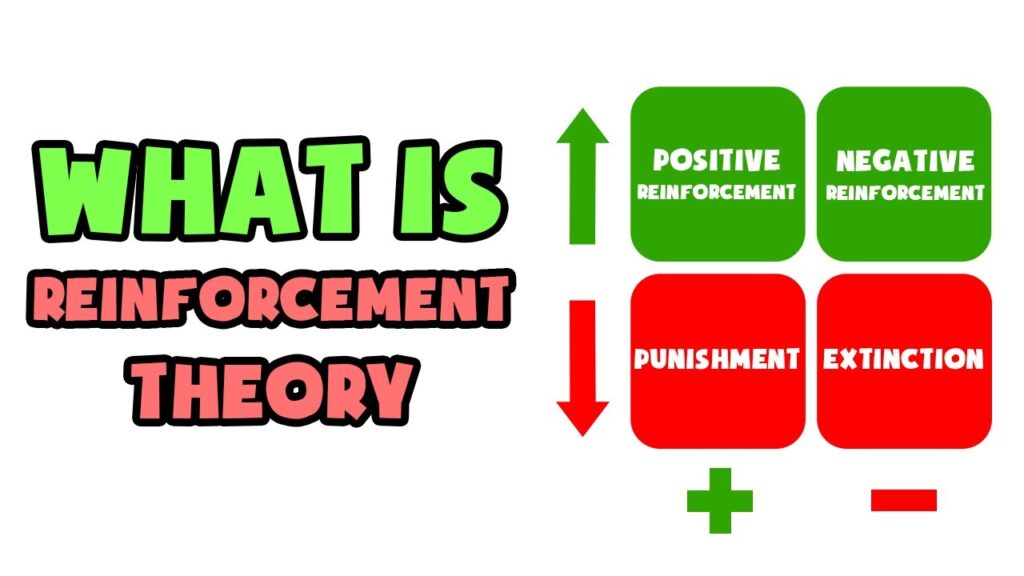
Reinforcement theory by B. F. Skinner
Reinforcement theory is a psychological principle suggesting that behaviours are shaped by their consequences, and that individual behaviours can be changed through reinforcement, punishment and extinction.
Behavioral psychologist B.F. Skinner was instrumental in developing modern ideas about reinforcement theory. According to Skinner, a person’s internal needs and drives are not important areas of concern because their current behaviours follow the law of effect and are based on the consequences of past behaviors. This means that behaviors can be altered or manipulated over time.
There are four types of reinforcements: positive reinforcement, negative reinforcement, extinction, and punishment. Positive reinforcement is the application of a positive reinforcers.
Positive reinforcement
one of the key ideas in the reinforcement theory of motivation is that positive reinforcement can with rewards reinforces desired behaviours. For example, appreciating an employee with a certificate, a holiday package, a promotion etc.
Negative reinforcement
Negative reinforcement involves the removal of disgust or aversion of the employee towards his work example is some penalty. This can be done with counselling with mentoring an employee etc.
Punishment
It’s used for maintaining a positive and productive work culture. Example is issuing a warning letter, reprimanding habitual late coming etc.
Extinction
Extinction reinforcement theory is a strategy in which employees are neither praised nor reprimanded for their work product, behaviour or team interaction. In this management scenario, workers don’t run the risk of workplace humiliation, but they also forego recognition for a job well done.
When a person feels isolated from his/her group of acquaintances, family, friends, society the person feels alienated. The experience of being isolated is dreadful. When a person feels ignored, or left out alone, his enthusiasm and spirit of working drops. Employees become emotionally separated from others and their own feelings when they feel alienated. Feelings of alienation can happen without the employees or their manager realizing it.

Adams’ equity theory of motivation
Adam’s Equity Theory, also known as the Equity Theory of Motivation, was developed in 1963 by John Stacey Adams, a Belgian psychologist known for workplace behavior. When people exhibit inappropriate behavior in the workplace, everyone suffers. Equity Theory is based on the idea that individuals are motivated by justice. In simple terms, equity theory states that if an individual identifies an inequity between himself and a peer, he automatically will adjust his working style to make the situation fair in his own eyes. As an example of equity theory, if an employee learns that a peer doing exactly the same job as him is earning more money, he may choose to do less work, thus feeling justified in his own eyes.
The structure of equity in the workplace is based on the ratio of inputs to outcomes. Inputs are the contributions made by the employee for the organization. Inputs for instance come in form of the number of hours worked (effort), the commitment shown, the enthusiasm shown, experience brought to the role, personal sacrifices made, responsibilities and duties of the individual in the role. Outputs are the result an individual receives as a result of their inputs to the organization. Some of these benefits will be tangible, such as salary and promotion, but others will be intangible, such as recognition and appreciation. Common outputs include salary, bonus, pension, annual holiday allowance, company car, company home, stock options, recognition, and promotion.
The more appealing and enjoyable the organization culture is, the happier their employees will be. It is not possible for a worker to be genuinely engaged when they are unhappy. Employees keep comparing with each other in regards to salary, perks, recognition and promotion. By cultivating a strong corporate culture, organizations increase the chances of good employee engagement. And, engaged employees are more likely to be great advocates of the organization brand. When organizations maintain rational inputs and outputs, they get clarity in defining equity. Equity is defined as an individual’s outputs divided by that same person’s inputs. Adam’s Equity Theory goes a step further and states that individuals look around and compare their promotions and perks to others in the same industry. If they perceive an inequity then they will adjust their inputs to restore balance.

Vroom’s expectancy theory
Victor Harold Vroom is a business school professor at the Yale School of Management. His expectancy theory of motivation is the belief that an individual chooses to behave in a particular way based on what could bring him the most beneficial outcome. Vroom’s expectancy theory assumes that employee behaviour results from conscious choices to maximize pleasure. Vroom noted through his study that an employee’s performance is based on individual factors such as personality, skills, knowledge, experience and abilities.
Vroom says that an individual’s motivation is affected by how much he is valued in his organization and rewards associated with it. This act is called Valence. Employers must recognize that employees will put efforts which will generate good results which Vroom calls Expectancy.
Valence
Valence refers to the emotional orientation of people with respect to outcomes (rewards). The depth of the want of an employee for extrinsic satisfaction includes money, promotion, time-off, leave benefits etc. For intrinsic satisfaction rewards such as sense of fulfilment, sense of achievement is important. Management must find out what an employee values – extrinsic or intrinsic satisfaction.
Instrumentality
Instrumentality is the perception of employees as to whether they will actually get what they desire. Sometimes the boss promises additional perks or benefits – often the promises are not fulfilled. Management must ensure that promises made must be fulfilled.
Motivation is a function of valence, instrumentality and expectancy. M = V x I x E
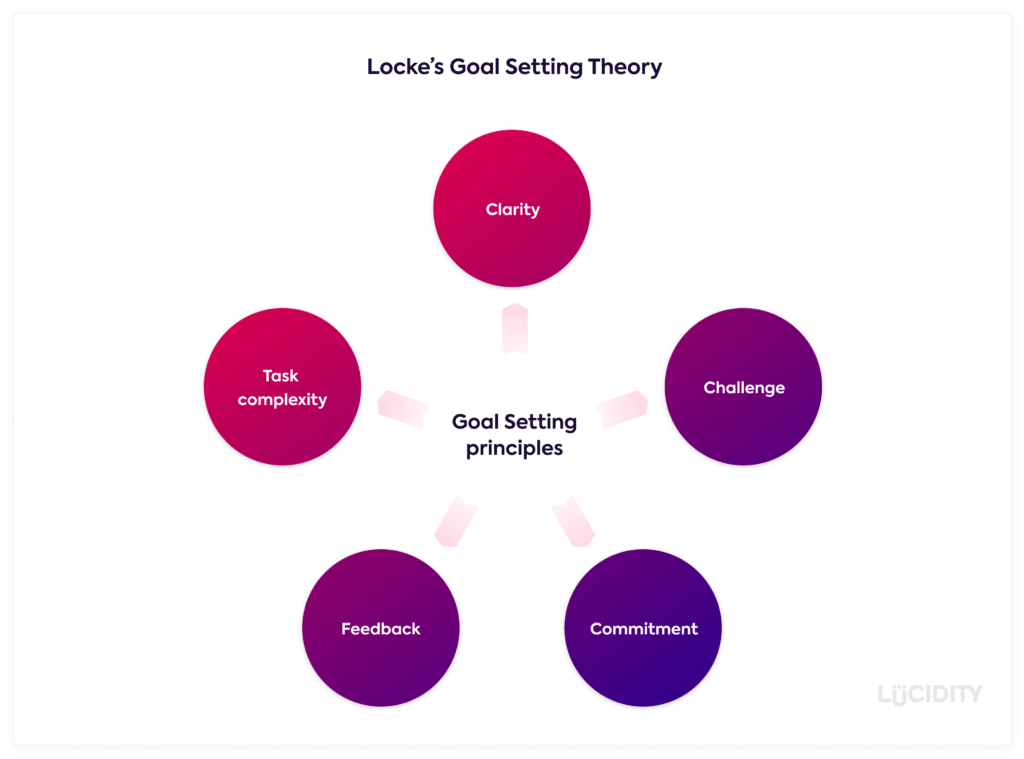
Locke and Latham’s goal-setting theory
Dr Edwin Locke and Dr Gary Latham spent many years researching the theory of goal setting, during the time spent on the research, they identified five elements that need to be in place for individuals to achieve goals.
Clarity, Challenge, Commitment, Feedback and Task Complexity.
Clarity
A clear, measurable goal is more achievable than one that is poorly defined. The most effective goals have a specific timeline for completion.
Challenge
The goal must be little challenging in order to achieve it. If the goal is easily met, it becomes a plain achievement.
Commitment
one needs to put thoughtful effort into meeting a goal. When you share your goal with someone else in order to increase your accountability you will put in efforts to achieve that goal.
Feedback
For achieving a set goal one must learn to take feedback from genuine people from time to time.
Task Complexity
If a goal is especially complex, make sure you give yourself enough time to overcome the learning curve (involved in completing the task. In other words, if a goal is really tough, make sure you give yourself some padding to give you the best chance at succeeding.













































